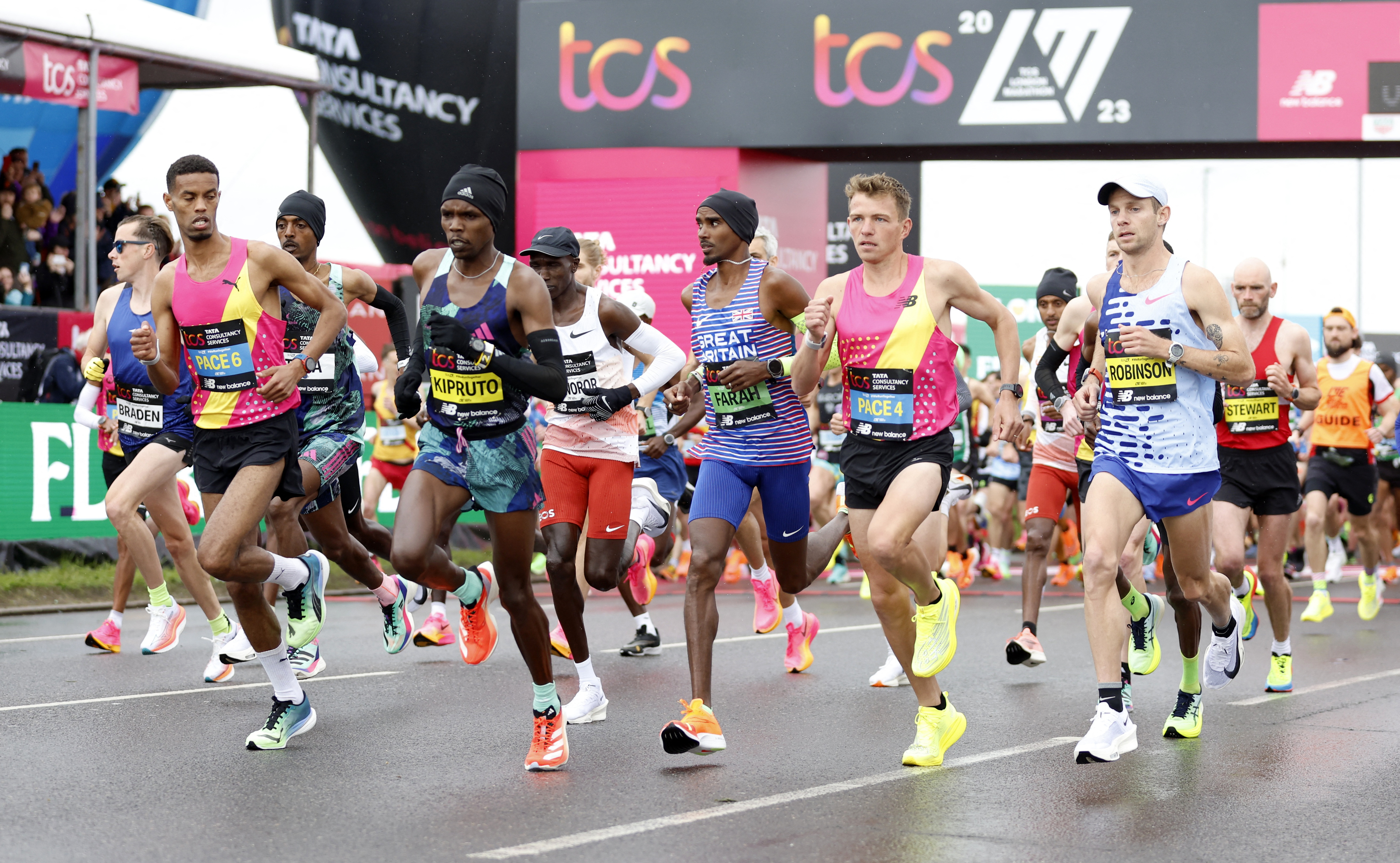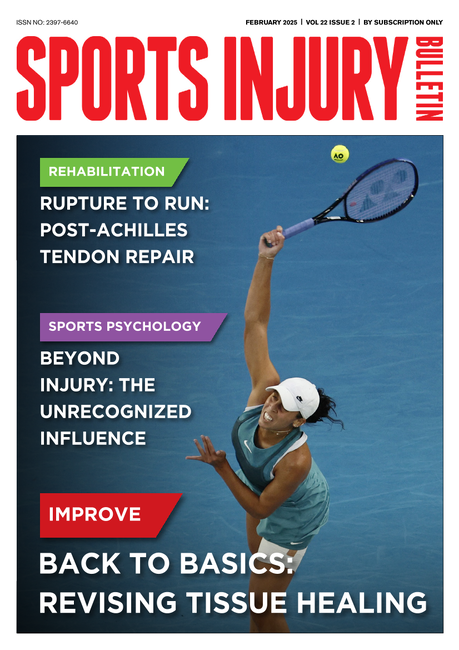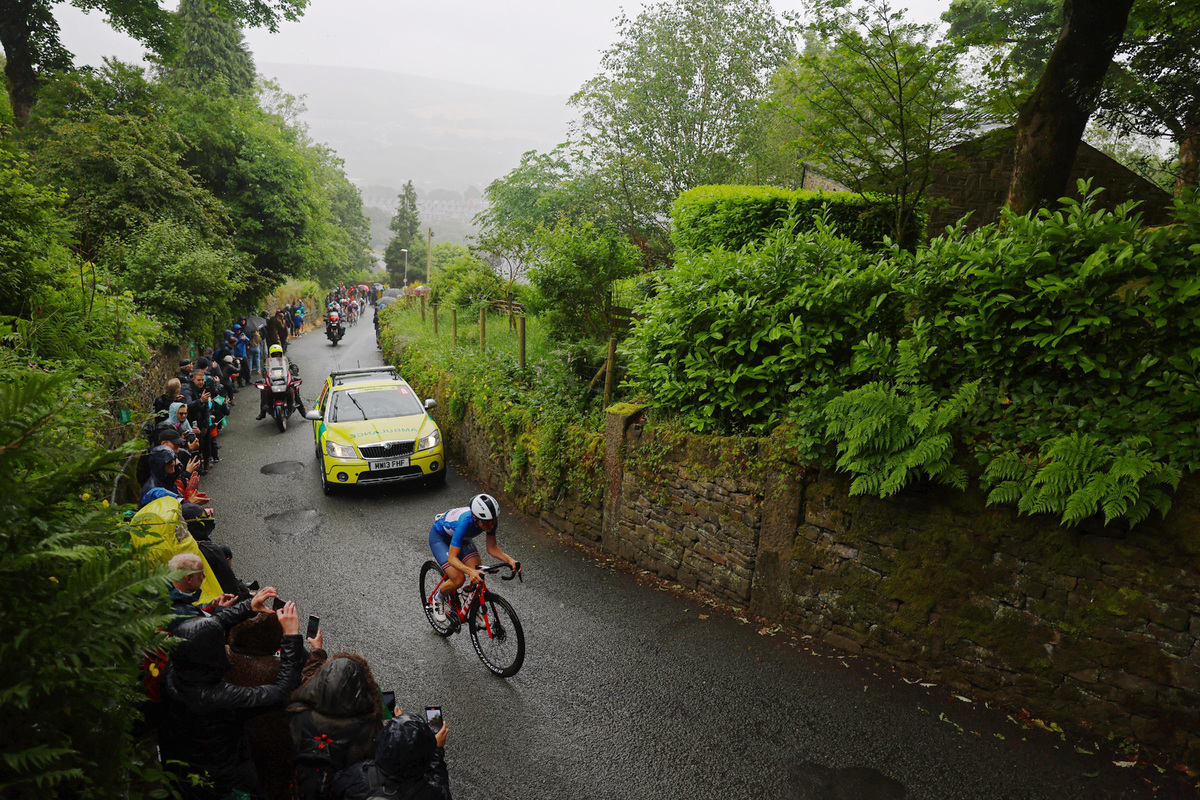You are viewing 1 of your 1 free articles
Pelvic stress fracture: a rare but real risk in distance athletes
Adam Smith looks at what the recent says about the diagnosis and treatment of pelvic and hip stress fractures in athletes.
Athletics - London Marathon - London, Britain - April 23, 2023 Britain’s Mo Farah, Australia’s Brett Robinson and Kenya’s Amos Kipruto in action at the the start of the elite men’s race REUTERS/Peter Cziborra
Stress fractures are a rare cause of pain in the general sporting population with some reports indicating that they account for only 2% of all reported injuries. A significantly higher incidence of stress fractures is seen in long distance runners and triathletes(1).
Stress fractures around the pelvis are relatively rare but must be considered as a differential diagnosis when athletes (particularly long distance runners and triathletes) report hip/groin or buttock pain during and after running. This article will focus on stress fractures around the pelvic/ hip region including sacral, pubic rami and femoral neck. The anatomy, clinical presentation, diagnosis and treatment for each of these types of stress fractures will be discussed.
Table 1: Location of sacral stress fractures
| Location | Potential complications | |
| Zone 1 | Lateral portion of sacrum/ sacral wing/ala | No neurological symptoms, but occasionally nerve roots can be involved |
| Zone 2 | Sacral Faramina (excluding sacral canal) | Associated with lumbosacral radiculopathies |
| Zone 3 | Body and canal of sacrum bilateral neurological symptoms | bilateral neurological symptoms — saddle anaesthesia and loss of sphincter tone |
Why do stress fractures occur?
Stress fractures occur over time when bone can no longer withstand submaximal repetitive forces. They have been described as either insufficiency (when normal stresses result in fracture of a bone with decreased bone density – i.e., in an elderly osteoporotic patient) or fatigue fractures (when abnormal stress is placed on normal bone and a fracture occurs – i.e., long distance runner)(2). This article will focus on fatigue fractures.
When bone is subjected to loading, the initial physiological response is a relative increase in osteoclastic activity (bone resorption) and thus temporary structural weakening occurs prior to new bone formation. If these stresses continue to occur without adequate time for the bone to adjust then ongoing osteoclastic activity exceeds bone regeneration and microfractures occur(3).
The earliest feature of a stress reaction seen on imaging is bone oedema on MRI, and increased activity on bone scan. Bone scan in the acute phase has high sensitivity but low specificity, and increased uptake may also be due to infection, bone infarction or neoplastic activity(4). Latshaw et al stated that 60-70% of x-rays in the acute phase of a stress fracture (less than 2 weeks) show a negative result(5). Due to its lack of radiation, high sensitivity and high specificity MRI (despite its higher cost) is often the most favoured modality to identify stress fractures in the early phases.
A variety of different intrinsic and extrinsic factors have been identified as risk factors for stress fractures. These include, but are not limited to, shoes, biomechanics, nutrition, strength, flexibility and hormonal or menstrual disturbances. These all must be considered when assessing a patient with a suspected stress fracture. Johnson et al found in their analysis of 8 female athletes with sacral stress fractures that the most significant risk factor for these types of fractures was a rapid increase in impact activity with a more vigorous exercise program(6). A spike in workload should therefore be considered a significant risk factor for a stress fracture.

Figure 1: Structure of the sacrum

Figure 2: Sacral architecture
The sacrum (like an inverted arch) supports the entire upper body weight and transfers force to the pelvis.
Sacral Stress Fractures
Anatomy
The sacrum generally consists of 5 fused vertebrae (S1-S5) and is triangular in shape (see figure 1). It articulates with the ilium at the sacroiliac joint and has been described due to its shape and its role in the distribution of forces as the keystone to the arch of the pelvis (see figure 2).
Longhinio et al described sacral fractures according to their location (see table 1)(7). Sacral stress fractures most commonly occur in zone 1 and are more often seen in women. It has been proposed that the shape of the female pelvis leads to less efficient weight distribution through the sacrum than the typical male pelvis(8). However, it’s also true that several male elite Australian triathletes have suffered sacral stress fractures in recent years.
Clinical presentation
An athlete with a sacral stress fracture will often present with acute onset back, buttock or hip pain that they describe occurred suddenly during a run and they will report that they were unable to continue that run. They may have restricted back movements, and may or may not have pain on palpation of the sacrum. Often they have no neurological symptoms. Pain or tightness will be experienced walking and they will have pain on hopping on the affected side. They also commonly report pain on single leg loading tasks – for example putting trousers on.
Diagnosis
Due to the excessive overlying soft tissue, complex bone anatomy and/or overlying tissue, plain radiographs rarely show a sacral stress fracture(8). Bone scan, MRI or CT can be used to detect a sacral stress fracture; MRI is often the modality of choice due to the lack of radiation. CT and MRI findings suggest that sacral stress fractures occur due to repeated compressive forces resulting in shear microfractures of the trabecular bone(6). These fractures rarely produce a visible callus on plain radiograph so MRI or CT should be used for follow up imaging if poor healing is suspected(8).
Treatment
As these are stable fractures, treatment progression is largely based on the athlete’s symptoms and will progress from non-weight bearing to weight bearing to gradual return to run as symptoms subside. Generally a period of 6 weeks with no running followed by a 6-8 week period of gradual return to running is required. Most published literature shows a full return to activity by 4 months, with rare cases taking 14 months(8). Repeated CT scans 4 and 8 months after diagnosis often show no signs of previous fracture, which indicates a more rapid and complete healing of the well-vascularised trabeculae microfractures when compared to fractures that involve the less well-vascularised cancellous bone. Johnson et al showed that those women who had the best diets, regular menses and fewer prior stress injuries or menstrual irregularities healed the fastest(6).
Inferior Pubic Rami Stress Fractures
Anatomy
The inferior pubic ramus slopes downward and medial from the superior ramus, and becomes narrow as it descends. It is the attachment site for the adductor magnus, brevis and gracilis as well as obturator internus and externus (see figures 3a and 3b). Stress fractures of the inferior pubic rami have been reported in military recruits, runners and triathletes. They usually occur in the inferior pubic rami adjacent to the pubic symphysis. Miller proposed that these fractures occur due to repetitive forces transferred to bone through muscle contraction or fatigue(9). In a study on female military recruits Hill et al proposed that over-striding during marching was potentially a mechanism for pubic rami stress fractures(10).

Fig 3a: Anatomy of obturator externus and its insertion onto the inferior pubic rami

Figure 3b: Adductor brevis and gracilis insertion onto inferior pubic rami
Clinical presentation
These fractures often present either in competitive races or intensive training sessions. They commonly occur at the insertion of the adductors and/or external rotators of the hip. Athletes with pubic rami stress fractures will complain of pain in the hip, buttock, inguinal or adductor region that increases with activity and decreases with rest. They commonly limp and on clinical testing have pain with passive hip abduction, resisted hip adduction and resisted hip external rotation. Noakes et al stated that a stress fracture of the pelvis can be made with confidence even without radiographic evidence if the following 3 criteria are met(11).
- Running is impossible due to severe discomfort in groin area;
- Discomfort in groin with unsupported stance on affected leg (positive standing test);
- Deep palpation revels exquisite, nauseating tenderness localized to pubic ramis.
Diagnosis
Plain radiographs may show undisplaced fracture lines but a lack of radiographic evidence in the early phases is not uncommon. Bone scan, CT or MRI may be used to identify fracture and bone oedema may be evident on MRI.
Treatment
These fractures have a high healing rate following 6-10 weeks of rest however they have a small risk of non-union and re-fracture when adequate rest has not been undertaken(11). Those fractures that show delayed union will likely show full recovery when further conservative management is undertaken(9). Progression of treatment should be guided by pain and thus initially, crutches may be required if walking is painful.
Femoral neck stress fractures
Anatomy
The femoral neck is the flattened, pyramid shaped piece of bone that connects the femoral head to the femoral shaft. Athletes with femoral neck stress fractures will report hip/groin pain when running. This pain usually has an insidious onset and generally worsens with the intensity or duration of a run. It may initially only occur at the end of a run but as the stress reaction worsens the pain presents earlier in the run, and progressively longer time is required after the run for symptomatic resolution. Athletes with femoral neck stress fractures may have hip/ groin pain at rest, and may wake with pain at night. They often also report pain with rolling in bed, active straight leg raise and single leg stance.
Femoral neck stress fractures are described as either ‘tension’ (superolateral or transverse) or ‘compression’ inferolateral stress fractures. Fracture displacement is the major determinant of outcome and tension stress fractures have a higher rate of displacement resulting in non-union, malunion or osteonecrosis(3). As a result tension stress fractures are considered more serious than compression fractures and may require surgical fixation(4).
Diagnosis
Conventional radiographs are often negative in the acute setting but may show signs in cases where symptoms have been present for 2 weeks or more. MRI is the gold standard for diagnosis and should be ordered when a stress fracture of the femoral neck is suspected.
Treatment
As mentioned, tension side stress fractures require immediate orthopaedic opinion due their risk of displacement. Compression side fractures are often managed conservatively with protected weight bearing and ongoing monitoring to assess healing. Initial phases of management should include non-weight bearing on crutches until no pain at rest, then progress to partial weight bearing to full weight bearing over a period of 4-6 weeks(10). A gradual return to run program can be commenced at 8-12 weeks once the athlete is able to walk without pain/symptoms.
Return to running
With all stress fractures around the pelvis, a gradual return to run plan is an important component of the rehabilitation process. To ensure progressive loading without spikes in workload, the return to run plan should be at least as long as the time off from running. For example if an athlete had a sacral stress fracture which required 6 weeks of no running then that athlete requires at least a 6-week gradual return to running plan before they could be at their previous running load.
A lower-limb strengthening program can be implemented quite early in the rehabilitation process initially starting with non-weight bearing exercises, which can be progressed as the athlete is able to weight bear without pain. Early strengthening can help to decrease muscle loss and address any biomechanical issues. As the fracture heals and the tolerance for load improves, these exercises can be progressed to higher-load exercises to prepare the body for the return to running.
References
- BMJ Open. 2012 Nov 19;2(6)
- Current Sports Medicine Reports 2006; Vol 5 37-43
- Sports Medicine and arthroscopic review 2012. Vol 20 No 4 206-213
- British Journal of radiology 2012; 85 1148-1156
- American Journal of Sports Medicine 1981. Vol 9, No 1 54-57
- American Journal of Sports Medicine 2001 Vol 29, No4 498-508
- Clinical cases in mineral and bone metabolism 2011; 8 (3), 19-23
- Current Sports medicine reports 2007. Vol 6 39-42
- Sports Medicine 2003; Vol33, No13, 1003-1012
- Journal of Bone and Joint Surgery 1996. Vol 78, No3, 383-386.
- American Journal of Sports Medicine 1985. Vol 13, no 2 120-123
Newsletter Sign Up
Subscriber Testimonials
Dr. Alexandra Fandetti-Robin, Back & Body Chiropractic
Elspeth Cowell MSCh DpodM SRCh HCPC reg
William Hunter, Nuffield Health
Newsletter Sign Up
Coaches Testimonials
Dr. Alexandra Fandetti-Robin, Back & Body Chiropractic
Elspeth Cowell MSCh DpodM SRCh HCPC reg
William Hunter, Nuffield Health
Be at the leading edge of sports injury management
Our international team of qualified experts (see above) spend hours poring over scores of technical journals and medical papers that even the most interested professionals don't have time to read.
For 17 years, we've helped hard-working physiotherapists and sports professionals like you, overwhelmed by the vast amount of new research, bring science to their treatment. Sports Injury Bulletin is the ideal resource for practitioners too busy to cull through all the monthly journals to find meaningful and applicable studies.
*includes 3 coaching manuals
Get Inspired
All the latest techniques and approaches
Sports Injury Bulletin brings together a worldwide panel of experts – including physiotherapists, doctors, researchers and sports scientists. Together we deliver everything you need to help your clients avoid – or recover as quickly as possible from – injuries.
We strip away the scientific jargon and deliver you easy-to-follow training exercises, nutrition tips, psychological strategies and recovery programmes and exercises in plain English.










